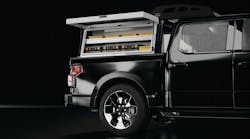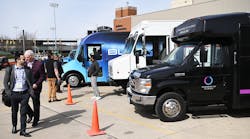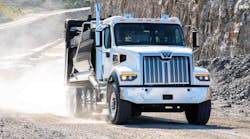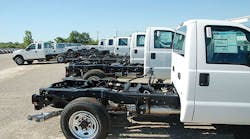Truck-equipment manufacturers and distributors are always looking for products they can sell to existing or new customers. When it comes to fleets, the key is to look beyond the obvious — chassis, truck bodies, and truck-mounted accessories.
In a National Truck Equipment Association (NTEA) webinar, “Doing Business with Fleets,” NTEA director of fleet relations Bob Johnson said the typical vocational fleet will have one or more groups of core vehicles. In the case of a company like Telcom, it might be vans, pickups, Class 2-3 chassis cabs, service bodies, and bucket trucks.
“If you look beyond the core assets, you'll see they have special-application vehicles that differ from the fleet's core makeup, and their core suppliers may not be able to supply those, so it's an opportunity if those specialty units tend to align with your products,” Johnson said. “Telecom may have dry-freight boxes anywhere from Class 2-8, flatbeds without cranes for loading materials, and even dump trucks. So don't hesitate to look beyond the typical vehicles a fleet has to take advantage of opportunities for business.”
He said that there are new technology requirements, and for fleets, it's both front-end-loaded and back-end-loaded. On the front end, fleet managers are looking for ways to include production of vehicles, reduce operating costs, and extend life. It may be through the use of telematics, or energy-reduction green technology such as idle reduction and weight reduction. On the back end, technology has impacted the way customers do business and has created requirements for vehicles that did not exist even a few years ago.
“You may actually find over a period of time that technology is actually changing what the core makeup of the fleet is,” he said. “Keep up to date and see where your product lines fit in.
“There are new business ventures, not only startups but existing customers who have expanded product lines. This may create the need for vehicles different from the original core. There are also new regulatory requirements. We are all familiar with regulations' impact on the fleet side — everything from the need for hands-on communication to emissions reduction to the means to comply with new regulations such as CSA. That may be creating business requirements you may be in a position to fill. Don't hesitate to contact fleets if you have a product that can serve them.”
Then the question becomes: How do you determine your point of contact?
“Are you dealing with the right people?” he asked. “When you move to a new potential customer, one of the most difficult things is determining who you want to talk to. It may be a fleet manager or purchasing manager or somebody in operations. The important thing is to not waste a lot of time talking to the wrong people. The sooner you can target the right person, the better off you are. Depending on who the person is, it may have a significant impact on the way you represent yourself to that potential customer.”
Nailing down the values
He said it's also critical to learn as quickly as possible what their values are and what they expect to receive.
“If your value proposition is not what they're expecting, you're better off not pursuing them,” he said. “When I was a fleet engineering manager for a utility company many years ago, I had a supplier approach me to do business. They went to the extreme of actually building a demo unit to my specifications, which they brought in and gave to us for a field test. It worked out fine and we were satisfied. At that point, we told them our delivery requirements and they immediately said, ‘We can't meet that requirement and we can't do business with you.’ So they wasted the cost of building the demo unit and weeks of their time only to discover our value propositions didn't match.”
The customer-supplier relationship must be defined, he said. A customer might want a short-term single order or a long-term multi-year order.
“They may want to deal with you at arm's length,” he said. “This is especially true with regulated entities and government fleets. In some cases, they may want all communication to be in writing or electronics. On the other hand, you may have customers who want to work very closely and even help you develop specifications and design vehicles. At the extreme end, you may have a customer who wants you to develop a full partner and actually come into their business and help them run it from a fleet aspect. Those are becoming much more common today. As experienced fleet managers retire, the people who replace them don't have knowledge and are depending more and more on you to help them do their job. It's a great opportunity as long as you live up to the agreement and help them do a better job running their fleets.”
Who is your customer? The company that is (or may be) buying your products? The fleet manager? The company purchasing group? The crews who will actually be using your products?
Johnson said the answer is, all of them.
“The company you're dealing with has to be comfortable and satisfied that the products and services you're providing are of long-term benefit to the company and will meet their needs with no long-term issues,” he said. “Fleet managers are primarily concerned with reducing operating costs, reducing maintenance costs, and assuring vehicles will be productive and have longevity. Purchasing groups, on the other hand, are typically focused on the first cost of the vehicle.
“End users often get overlooked, but they are extremely important as far as satisfying the overall business relationship. If end users don't like the equipment you provided them, those trucks or pieces of equipment will be high maintenance costs and short-lived, because users will literally beat a piece of equipment to death. Make sure it's convenient for users, safe, productive — basically something they can live with on a day-to-day basis.”
Analyzing the customer
The customer's business has to be understood:
-
How long do they keep their equipment? “This will have a bearing on how it's designed and built, and the materials you use.”
-
How do they maintain their equipment? “Do they do it in-house with their mechanics or take it to an outside vendor, who may or may not be experienced with that equipment?”
-
Do their operators need additional training? “It's quite common for everybody to assume the operator knows how to use the equipment, when in reality he may not.”
-
How will they actually use your products? “Everybody here on this (webinar) builds a product and has a pretty good idea of how it's intended to be used. But end users will use it however they have to get the job done. It may not be as you intended it. They may be abusing it. But fact is, they have a job to do. You may be surprised to learn your equipment is being abused beyond any expectation.”
-
Are they using the right equipment? “They may be abusing it because they don't really have the equipment they need to do the job. That's where you get the opportunity to be proactive. As you interface with the customer, you learn more and more and you can put yourself in a position where you can recommend changes to the design and specifications of products. It makes them better — not necessarily lower costs up-front but lower life-cycle costs and more productive. Many fleet managers in today's world are not that experienced. They maybe didn't have a day of experience in fleets before they became fleet manager. Technology may be moving rapidly on their side but it's also moving fast on your side. Make sure you introduce those to the purchase people in fleets. Work with end users as they hire new people and change applications or equipment, and provide training as appropriate. Typically this requires the permission of the company you're dealing with and, in most cases, they're happy to do it.”
Johnson said a proactive approach is necessary, including: recommending changes to designs and specifications to improve the end product; introducing new products and technologies; working with end users in training when appropriate; and providing appropriate after-the-sale support.
“I can't emphasize this enough,” he said. “One of the worst things you can do is make a sale and walk away. The average fleet manager has an extremely long memory. They can probably tell you 15 years from now what a company did that put them in a bind.”
How fleets decide
Typical fleet acquisition decision factors include: lowest first cost; lowest routine operating cost; lowest maintenance costs; maximum productivity (“it's very important if the end-user groups are calling the shots); and lowest total cost of ownership (“they are getting beyond the lowest first cost and what's best for Budget Center A versus Budget Center B by looking at the total cost of ownership.”)
He said that with the exception of “lowest first cost,” all of these decision factors represent some variation of life-cycle costing.
“As a supplier, if you can educate your customer of the benefits of looking at the total overall cost of the vehicle — the true life-cycle cost,” Johnson said. “You may put yourself in a position where you can increase the quality of products, which in the long term will make a better, more satisfied customer.”
Johnson said single-factor evaluations are typically internalized to a single cost/budget center.
“The organizational structure of the fleet frequently determines which factors will be considered when making a life-cycle cost analysis,” he said. “If you take all these factors and roll them together — productivity, operating costs, maintenance costs — and add a few other factors in, you get into true life-cycle cost evaluations. This is where you look at the lowest total cost of ownership. The lowest total cost-of-ownership life-cycle cost evaluations identify what is best for the entire organization.
“Consider other factors — return on investment, the time value of money. A lot of government agencies will tell you they don't have to worry about that. We all know that everybody has a cost of money. Even government fleets should really be interested in the return on their investment. Also consider the impact of taxes on operating costs — tax-paying entities. The concept of looking at return on investment and tax issues is somewhat foreign to many first- and second-line managers. Unless they had training in finance, they may not even understand what you're talking about. If you're going to use life-cycle costing to leverage your position, you may have to educate the people you're dealing with.
“Using life-cycle cost analysis as a sales tool, you may be able to get beyond the lowest first cost and demonstrate to the customer that they might be better off paying more up-front. It's a big job to make that jump, but once you've done it, you will find yourself well-positioned with the company. If you're working with a company that uses single-factor analysis, learn what factors they take into consideration and be prepared to demonstrate that your offering is the best value. You have to learn all you can about the company and be able to demonstrate to them the benefits of taking all aspects of ownership into consideration.”
The lowest total cost of ownership documents the customer's potential ROI, he said. Once the fleet manager has been educated and talk to his finance people, it increases his professionalism and makes him look better to the finance group — and may actually make it easier for him to get money.
He suggested using the NTEA's Life-Cycle Cost Analysis Template to simplify the analysis. There are two versions: the vehicle template and property, plant, and equipment template.
“The primary difference is that the vehicle template is set up to take the cost of fuel into consideration,” he said. “The property, plant, and equipment template allows you to use multiple costs of money, depending on whether it's a long-term investment or short-term investment. Both operate as Excel spreadsheets and are very simple to use, and contain well-documented explanations.”
Both templates cost $49 for NTEA members and $89 for non-members. They can be used to calculate annual and total cash flows as well as the net present value of the various cost and revenue streams associated with the ownership of a vehicle over the life of the asset at any given internal rate of return. It also allows users to perform “what if” scenarios.
“Once you introduce yourself to a potential customer, it may take you several years to actually get the business,” he said. “The more you can introduce them to a factor they had not previously considered — new technology and the use of life-cycle costs — the sooner you get your foot in the door and get an opportunity to do business with them.









